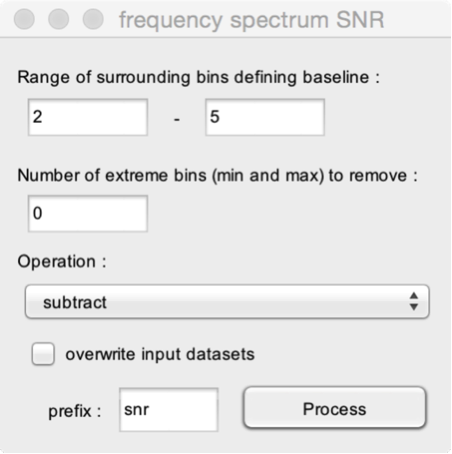-
Notifications
You must be signed in to change notification settings - Fork 30
Baseline operations
André Mouraux edited this page Apr 8, 2015
·
2 revisions
Baseline operations are used to express signals (epoched data) relative to a reference interval.
This function is used to apply a baseline correction to epoched EEG data. This allows expressing signals relative to a reference interval (e.g. a time interval before the onset of the stimulus).

- Baseline operation. Several operations are available : subtract (remove the mean of the signal amplitude measured during the reference interval), ER% (express signal amplitude as the percentage of change relative to the mean of the signal amplitude measured during the reference interval), divide (express the ratio between signal amplitude and the mean of the signal amplitude measured during the reference interval) and zscore (express the signal as standard deviation relative to the distribution of the signal measured during the reference interval).
- Reference interval. The begin and end of the reference interval. For example, the reference interval can be defined as the 0.5 s preceding the onset of the stimulus (begin : -0.5 s, end: 0.0 s).
This function is used to express the magnitude of steady-state evoked potentials (SS-EPs) identified in frequency spectra relative to the amplitude of the spectra obtained at neighbouring frequency bins. The function can be viewed as a method to apply a baseline correction in the frequency domain. See Nozaradan et al. 2011 for an example.

- Range of surrounding bins defining baseline. Each bin of the frequency spectrum will be expressed relative to the amplitude of the frequency spectrum obtained at surrounding bins. This parameter defines the range of surrounding frequency bins that should be used to compute the baseline operation. In this example, each bin (i) will be expressed relative to bins (i-2 to i-5 and i+2 to i+5). When defining this interval, it is important to take into consideration the frequency resolution of your FFT, as well as the spread of your response (SS-EP) in the frequency domain (Is it restricted to a single frequency bin? does it spread to several frequency bins?)
- Number of extreme bins to remove (min and max). This option allows discarding extreme values in the reference interval (defined by the range of surrounding bins). This can be useful to avoid effects due to the presence of artifacts in the surrounding frequency bins.
- Operation. Several operations can be applied: subtract (subtract the mean of the reference interval), SNR (express as the ratio of the reference interval), zscore (express as the standard deviation relative to the distribution of the reference interval), percent (express as percentage of difference relative to the mean of the reference interval).
Plugins
User interface
File
Edit
Events
- Browse and edit events
- Delete duplicate events
- Create events from level trigger
- Merge event codes and latencies
Pre-processing
- DC removal and linear detrend
- Reference
- Frequency filters
- Spatial filters (ICA)
- Epoch segmentation
- Baseline operations
- Artefact rejection and suppression
- Current source density (CSD)
- Frequency and time-frequency transforms
- Time-frequency filters
- Resample signals
- Resample signals
- Arrange signals
Post-processing
- Average
- Single-trial analysis
- Math
- Source analysis (dipole fitting)
- Find peaks in waveforms
- Global explained variance
Statistics
- Compare datasets against a constant
- Compare two datasets
- Compare more than two datasets (ANOVA)
- Compare signal amplitude at event latencies
- Bootstrap test against a reference interval
Figures